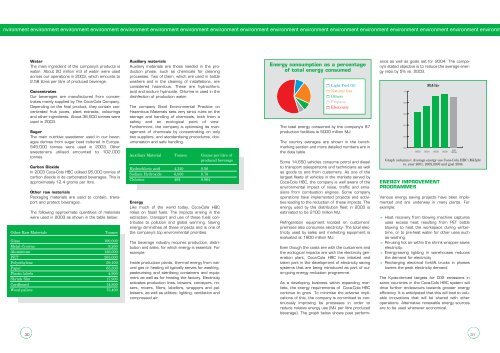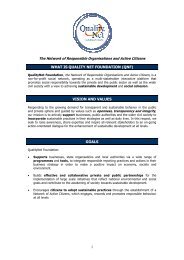APOLOGISMOS CCHBC final - Coca-Cola Hellenic
APOLOGISMOS CCHBC final - Coca-Cola Hellenic
APOLOGISMOS CCHBC final - Coca-Cola Hellenic
Create successful ePaper yourself
Turn your PDF publications into a flip-book with our unique Google optimized e-Paper software.
nvironment environment environment environment environment environment environment environment environment environment environment environment environment environment environment environment environm<br />
Other Raw Materials<br />
Water<br />
The main ingredient of the company’s products is<br />
water. About 20 million m3 of water were used<br />
across our operations in 2003, which amounts to<br />
2.58 litres per litre of produced beverage.<br />
Concentrates<br />
Our beverages are manufactured from concentrates<br />
mainly supplied by The <strong>Coca</strong>-<strong>Cola</strong> Company.<br />
Depending on the <strong>final</strong> product, they contain concentrated<br />
fruit juices, plant extracts, colourings<br />
and other ingredients. About 36,600 tonnes were<br />
used in 2003.<br />
Sugar<br />
The main nutritive sweetener used in our beverages<br />
derives from sugar beet cultured in Europe.<br />
545,000 tonnes were used in 2003. Other<br />
sweeteners utilised amounted to 102,000<br />
tonnes.<br />
Carbon Dioxide<br />
In 2003 <strong>Coca</strong>-<strong>Cola</strong> HBC utilised 95,000 tonnes of<br />
carbon dioxide in its carbonated beverages. This is<br />
approximately 12.4 grams per litre.<br />
Other raw materials<br />
Packaging materials are used to contain, transport<br />
and protect beverages.<br />
The following approximate quantities of materials<br />
were used in 2003 as shown in the table below:<br />
Tonnes<br />
Glass 190,000<br />
Metal Crowns 9,200<br />
Aluminium 126,000<br />
PET 263,000<br />
Polyethylene 59,100<br />
Paper 65,500<br />
Plastic labels 4,900<br />
Shrink film 17,900<br />
Cardboard 14,800<br />
Wood pallets 73,400<br />
Auxiliary materials<br />
Auxiliary materials are those needed in the production<br />
phase, such as chemicals for cleaning<br />
processes. Two of them, which are used in bottle<br />
washers and in the cleaning of installations, are<br />
considered hazardous. These are hydrochloric<br />
acid and sodium hydroxide. Chlorine is used in the<br />
disinfection of production water.<br />
The company Good Environmental Practice on<br />
Hazardous Materials sets very strict rules on the<br />
storage and handling of chemicals, both from a<br />
safety and an ecological point of view.<br />
Furthermore, the company is optimising its management<br />
of chemicals by concentrating on only<br />
two suppliers, and standardising procedures, documentation<br />
and safe handling.<br />
Auxiliary Material Tonnes Grams per litre of<br />
produced beverage<br />
Hydrochloric acid 4,320 0.56<br />
Sodium Hydroxide 6,000 0.78<br />
Chlorine 492 0.064<br />
Energy<br />
Like much of the world today, <strong>Coca</strong>-<strong>Cola</strong> HBC<br />
relies on fossil fuels. The impacts arising in the<br />
extraction, transport and use of these fuels contributes<br />
to pollution and global warming. Saving<br />
energy diminishes all these impacts and is one of<br />
the company’s top environmental priorities.<br />
The beverage industry requires production, distribution<br />
and sales, for which energy is essential. For<br />
example:<br />
Inside production plants, thermal energy from natural<br />
gas or heating oil typically serves for washing,<br />
pasteurising and sterilising containers and equipment<br />
as well as for heating the factory. Electricity<br />
activates production lines, blowers, conveyors, rinsers,<br />
mixers, fillers, labellers, wrappers and palletisers,<br />
as well as utilities; lighting, ventilation and<br />
compressed air.<br />
Energy consumption as a percentage<br />
of total energy consumed<br />
Light Fuel Oil<br />
Natural Gas<br />
Others<br />
Propane<br />
Electricity<br />
The total energy consumed by the company’s 87<br />
production facilities is 5000 million MJ.<br />
The country averages are shown in the benchmarking<br />
section and more detailed numbers are in<br />
the data table.<br />
Some 14,650 vehicles consume petrol and diesel<br />
to transport salespersons and technicians as well<br />
as goods to and from customers. As one of the<br />
largest fleets of vehicles in the markets served by<br />
<strong>Coca</strong>-<strong>Cola</strong> HBC, the company is well aware of the<br />
environmental impact of noise, traffic and emissions<br />
from combustion engines. Some company<br />
operations have implemented projects and activities<br />
leading to the reduction of these impacts. The<br />
energy used by the distribution fleet in 2003 is<br />
estimated to be 2100 million MJ.<br />
Refrigeration equipment located on customers’<br />
premises also consumes electricity. The total electricity<br />
used by sales and marketing equipment is<br />
evaluated at 1800 million MJ.<br />
Even though the costs are with the customers and<br />
the ecological impacts are with the electricity generation<br />
plant, <strong>Coca</strong>-<strong>Cola</strong> HBC has initiated and<br />
taken part in the development of electricity saving<br />
systems that are being introduced as part of our<br />
on-going energy reduction programme.<br />
As a developing business within expanding markets,<br />
the energy requirements of <strong>Coca</strong>-<strong>Cola</strong> HBC<br />
continue to grow. To minimise the adverse implications<br />
of this, the company is committed to continuously<br />
improving its processes in order to<br />
reduce relative energy use (MJ per litre produced<br />
beverage). The graph below shows past performance<br />
as well as goals set for 2004. The company’s<br />
stated objective is to reduce the average energy<br />
ratio by 5% vs. 2003.<br />
1.0<br />
0.8<br />
0.6<br />
0.4<br />
0.2<br />
0.0<br />
MJ/ltr<br />
2000 2001 2002 2003<br />
ENERGY IMPROVEMENT<br />
PROGRAMMES<br />
goal<br />
2004<br />
Graph (columns): Average energy use <strong>Coca</strong>-<strong>Cola</strong> HBC (MJ/lpb)<br />
vs. year 2001, 2002,2003 and goal 2004.<br />
Various energy saving projects have been implemented<br />
and are underway in many plants. For<br />
example:<br />
Heat recovery from blowing machine captures<br />
uses excess heat resulting from PET bottle<br />
blowing to heat the workspace during wintertime,<br />
or to pre-heat water for other uses such<br />
as washing.<br />
Re-using hot air within the shrink wrapper saves<br />
electricity.<br />
Energy-saving lighting in warehouses reduces<br />
the demand for electricity<br />
Recharging electrical forklift trucks in phases<br />
lowers the peak electricity demand<br />
The Kyoto-derived targets for CO2 emissions in<br />
some countries in the <strong>Coca</strong>-<strong>Cola</strong> HBC system will<br />
drive further endeavours towards greater energy<br />
efficiency. It is anticipated that this will lead to valuable<br />
innovations that will be shared with other<br />
operations. Alternative renewable energy sources<br />
are to be used whenever economical.<br />
30<br />
31







